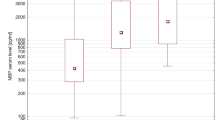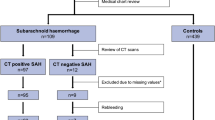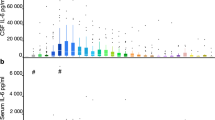Summary
Concentrations of S-100 protein in cerebrospinal fluid (CSF) were measured by a recently developed radioimmunoassay (RIA) in 45 patients with subarachnoid haemorrhage (SAH), 44 with verified ruptured aneurysm. In each of 43 patients 2–15 serial CSF samples were analysed, and in the remainder 1 sample was examined. The concentrations of S-100 protein proved to be related to the brain damage caused by the SAH, indexed as outcome (Glasgow Outcome Scale). The S-100 concentrations were related to the severity of the haemorrhage and to the development of delayed ischaemic deterioration. Delayed ischaemic deterioration (vasospasm) was usually accompanied by an increase in CSF S-100 concentration after 4 days. Patients in whom no S-100 value exceeded 20 ng S-100 per ml during the course of the disease had a favourable outcome, whereas patients in whom one or several CSF samples contained more than 100 ng/ ml became severely disabled or vegetative or died. The present study suggests that CSF S-100 analysis may be used as an objective and early measure of the degree of brain damage sustained by the SAH patient.
Similar content being viewed by others
References
Endo E, Tanaka T, Kasai H, Okuyama T, Hidaka (1981) Calcium dependent affinity chromatography of S-100 and calmodulin antagonist coupled sapharose. J Biol Chem 256: 12485–12489
Hårdemark H-G, Persson L, Gustavsson J, Rundström G, Mendel-Hartvig I, Esscher T, Påhlman S (1986) S-100 protein and neuron-specific enolase: CSF markers of cell damage in the central nervous system. Upsala J Med Sci [suppl] 43: 29
Hunt W, Hess R (1968) Surgical risk as related to time of intervention in the repair of intracranial aneurysms. J Neurosurgery 28: 14–20
Isobe T, Takahashi K, Okuyama T (1984) S-100aO protein is present in neuron of the central and peripheral nervous system. J Neurochem 43 (5) 1494–1496
Jennet B, Bond M (1975) Assessment of outcome after severe brain damage. The Lancet march 1: 480–484
Kanamori M, Suzuki Y, Ogura K, Kageyama N, Umekawa H, Hidaka H (1985) S-100 protein and calmodulin levels in cerebrospinal fluid after subarachnoid hemorrhage. J Neurosurgery 63: 417–421
Persson L, Hårdemark H-G, Gustafsson J, Rundström G, Mendel-Hartvig I, Esscher T, Påhlman S (1987) S-100 protein and neuron-specific enolase in cerebrospinal fluid and serum: Markers of cell damage in the human central nervous system. Stroke 18: 5: 911–918
Säveland H, Soneson B, Ljunggren B, Brant L, Uski T, Zygmunt S, Hindfelt B (1986) Outcome evaluation following subarachnoid hemorrhage J Neurosurgery 64: 191–196
Sindic C, Chalon M, Cambiaso C, Laterre E, Masson P (1982) Assessment of damage to the central nervous system by determination of S-100 protein in the cerebrospinal fluid. J Neurol Neurosurg Psychiatry 45: 1130–1135
Author information
Authors and Affiliations
Rights and permissions
About this article
Cite this article
Persson, L., Hårdemark, H., Edner, G. et al. S-100 protein in cerebrospinal fluid of patients with subarachnoid haemorrhage: A potential marker of brain damage. Acta neurochir 93, 116–122 (1988). https://doi.org/10.1007/BF01402892
Issue Date:
DOI: https://doi.org/10.1007/BF01402892




